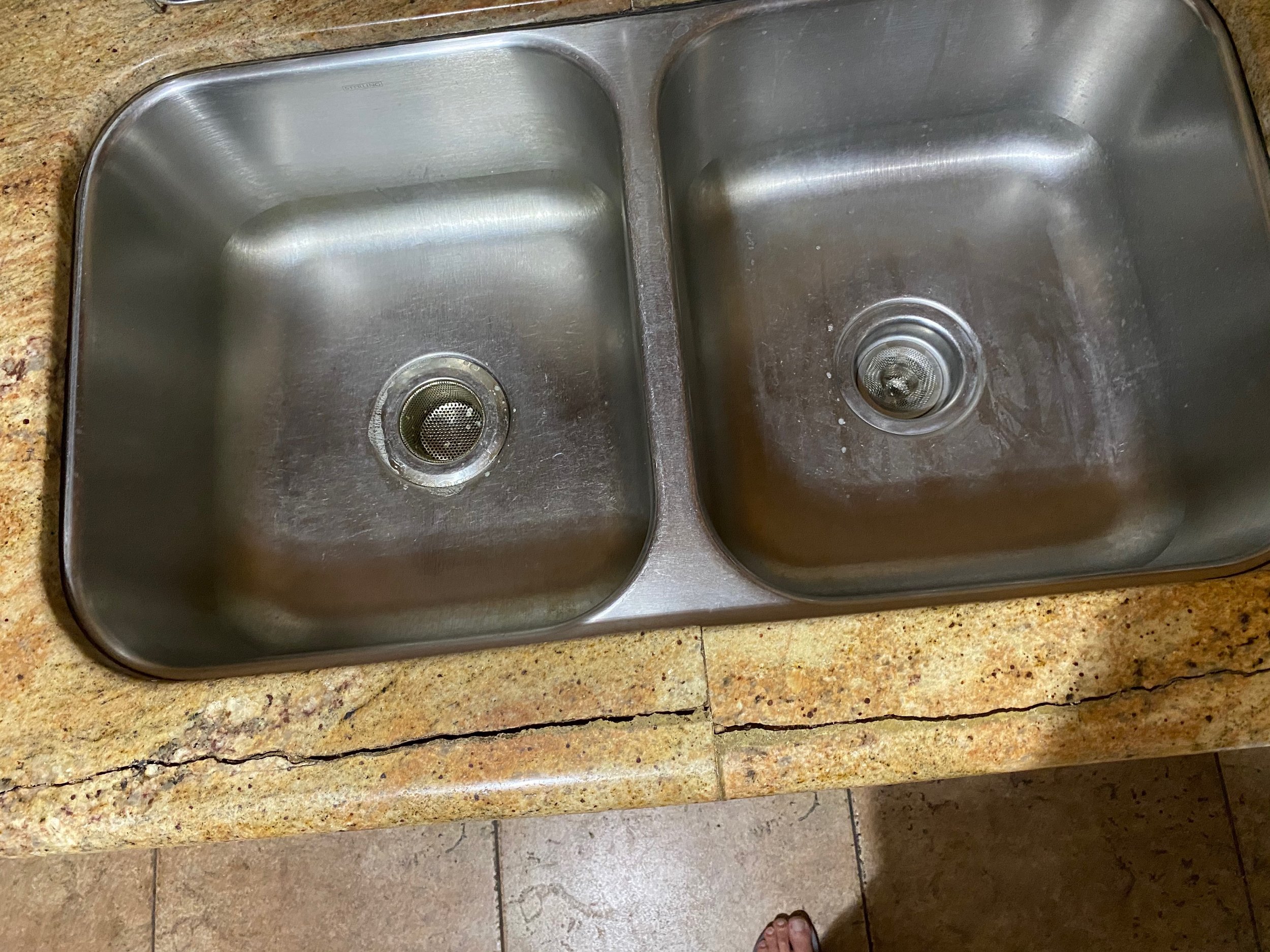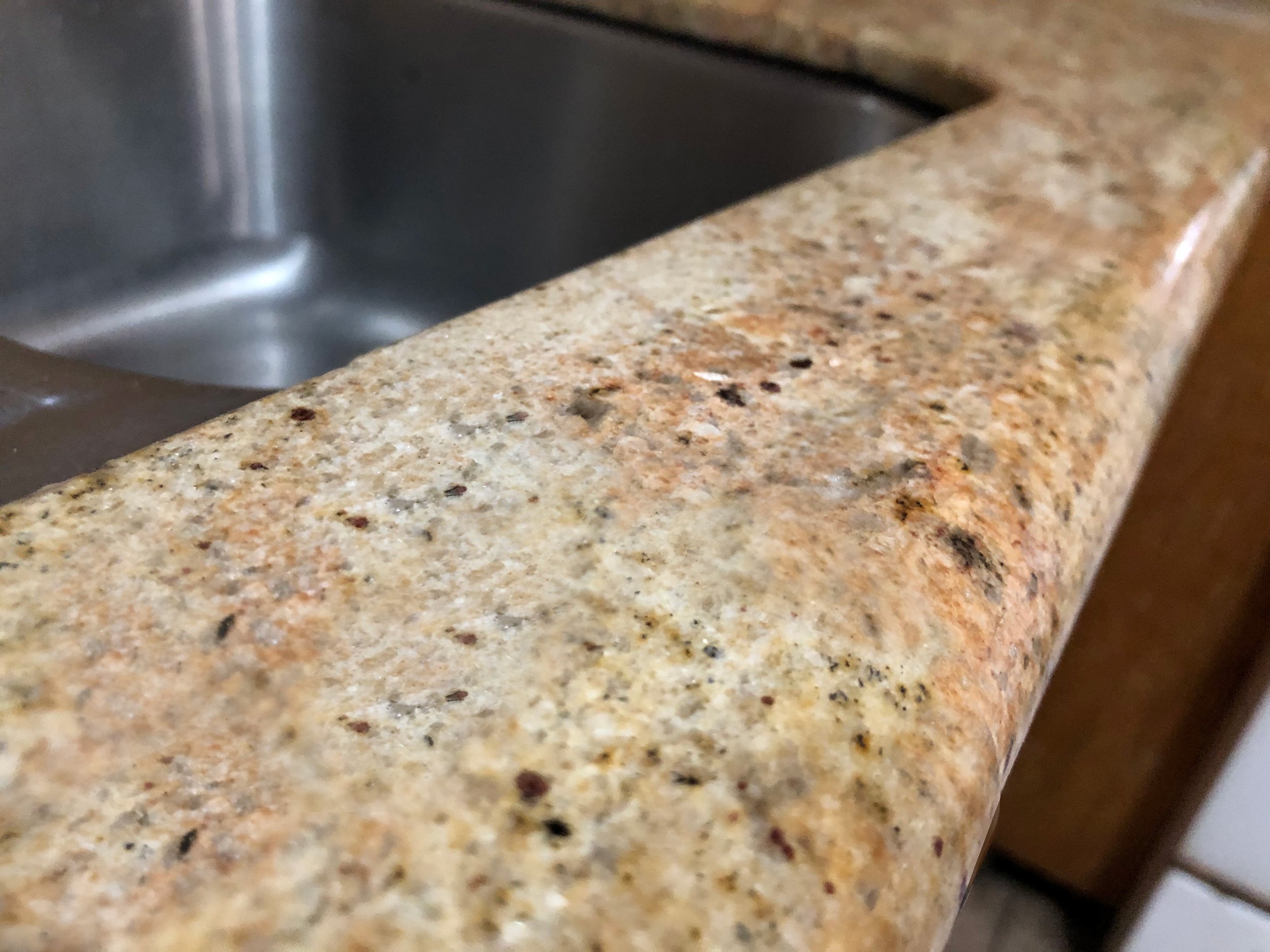Granite Crack
Composition of Granite
Granite is a wonderfully resilient material and a favorite to use for countertops. It is composed of crystals and minerals that make it extremely hard and dense. It is igneous which means it is a volcanic stone and made up of silica or silicates.
Pros About Granite
Granite is a desirable material because it has a high abrasion resistance and therefore is highly scratch resistant. Since granite does not contain calcium, it does not react with acids the way marble, limestone, and travertine do. You won’t find etch marks on granite countertops the way you would on calcareous stones. Homeowners love the low maintenance!
Porous Granite
However, granite is a porous material and when not cared for, it can absorb stains over time. Mostly, clients will find oil stains around or near the cooktop, along the seams at the countertop, and often around the sink. Coffee, wine, food particles, oils, acids, and virtually anything else can be absorbed into the pores of the granite countertop and sit there unbeknownst for years!
When this happens, the experienced technicians at CATA Stone Care & Restoration apply a special clay treatment to draw the oils up and out of the stone. This is a multi-step and multi-day process because the clay needs time to absorb the oils. Sometimes the clay treatment needs to be applied to the entire surface to ensure everything is evenly lifted. Otherwise some areas may look lighter than others. Once the stains are removed, the stone is cleaned, polished then sealed to prevent stains from being absorbed as easily in the future.
Pitting Repair
Where soap scum or mineral deposits have built up on granite that has not been cared for, those elements will be absorbed into the stone. If the granite comes into prolonged contact with moisture and if it has not been sealed, the water can eat away at the granite causing what is called “pitting”.
Pitting looks like little holes or rough areas in the granite. The experienced technicians at CATA Stone Care & Restoration will fill the pits with a special two-part epoxy specifically made for natural stone and color matched as best as possible. They will then polish the countertops flat to ensure a smooth and even finish.
Pitted Granite
Granite Countertop Maintenance
Regular maintenance on granite countertops will help keep surfaces looking great for years to come. Not to mention, they will keep the surfaces sanitary and free from anything that could be absorbed into the pores.
We recommend having granite countertops cleaned, polished and sealed every 2 to 5 years depending on how often the countertops are used. Our penetrating sealer is a very high quality sealer that helps to wake away moisture from the surface of the granite countertop. As a result, moisture and other common spills do not get absorbed as easily into the granite countertop, thus extending the life of your surfaces.
If your granite is scratched, then it needs stone restoration. Because granite is extremely hard and dense as we discussed earlier, it does not polish nearly as easily as a calcareous stone like marble, limestone or travertine. Granite stone restoration is a very technical process and must only be done by highly trained professionals.
Chipped granite corners can be filled with a special two-part epoxy and color-matched to the stone
Granite Crack Repairs
Granite crack repairs, particularly around the kitchen sink, are common household issues. Granite cracks are caused by a corroded metal rod that is located underneath the kitchen countertop. This rod is installed at the fabrication shop when the hole for the sink is cut by the fabricator. Its purpose is to ensure that the countertop is able to be transported safely from the fabrication shop to the project site.
If there is a granite crack repair, that means the caulking around the perimeter of the sink or at the backsplash has deteriorated, allowing water to seep behind the countertop and onto the rod. The rod then rusts, expands, and pushes the stone up causing it to crack.
A granite crack can only be repaired by an experienced technician. One way to repair the countertop is by using the injection method. For this repair, a special two part epoxy is injected into the crack to coat the corroded rod and slow down the oxidization process.
The second way, and the most fail-safe way to repair a granite crack, is using the extraction method. During this repair, the technician either cuts or breaks apart the stone to expose the rust and rod. He then cuts the rod out from underneath the countertop completely, thus removing the source of the cracking. He then pieces the stone back together using clamps and a special two-part epoxy made for stone. He color matches the stone as best as possible, grinds it flat, cleans and seals it. As long as the caulking around the perimeter of the sink and at the backsplash remains intact, the granite will not crack further.
To learn more, click here to read our blog post about Granite Crack Repairs.
Conclusion
It is important to maintain your granite countertops every so often with a clean, polish and seal service. Repairs due to staining, pitting, deteriorating caulking, or worse— cracking can become very expensive. However they won't be necessary if the countertops are regularly maintained by a trained service professional from CATA Stone Care & Restoration.







